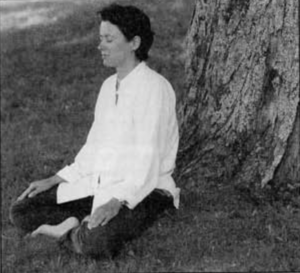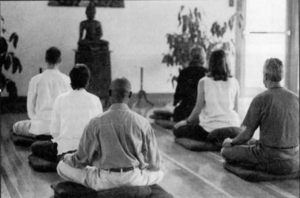“Attention all beings!” Only at IMS would an inter-office announcement be prefaced in quite this way. I smile in recalling this small event because these three words could be taken as their staff motto – perhaps to be engraved over the staff entrance just as the word ‘Metta’ appears over the front door. The integration of work and spiritual practice is central to all staff activities, and the results are apparent. Working in close quarters and sometimes with conflicting agendas, I found that IMS staff encounter nearly all of the discords that characterize other workplaces, but they manage to face them with a lightness and openness that prevents them from becoming major issues.
 I had the good fortune to be invited to spend six weeks, in the fall of 2000, as what is termed a ‘Working Guest.’ This program is one which depends on the serendipitous matching of IMS’s needs with available expertise, and so is not invoked on a routine basis. The organization was interested in having some assistance in its Registrar’s office and my university was willing to let me make an experience there central to a long-planned administrative leave. Almost two years of discussion and planning led to the six weeks.
I had the good fortune to be invited to spend six weeks, in the fall of 2000, as what is termed a ‘Working Guest.’ This program is one which depends on the serendipitous matching of IMS’s needs with available expertise, and so is not invoked on a routine basis. The organization was interested in having some assistance in its Registrar’s office and my university was willing to let me make an experience there central to a long-planned administrative leave. Almost two years of discussion and planning led to the six weeks.
My stay as a Working Guest coincided with Part I of the annual three-month retreat. I had the intention of working as much as required and of sitting when not working – so as to see from the experience, and on a day-to-day basis, how my work would inform my silence, and my silence my work. In fact I found that, on average, I worked perhaps four or five hours a day, sat for four hours a day, and of course was in the hall for the evening dharma talk. As is always the case, however, the actual experience was different than the expected one.
For years I have been in the habit of looking for ‘mindfulness bells’ as a re-call to attention during the work day. IMS makes it easy during a retreat, as bells ring regularly to announce the start of a meditation in the hall, or a meal or a talk. Staff meetings begin and end with a period of meditation, bracketed with the sound of a bell, and visual reminders abound. A small but not-to-be-missed sign on the door leading from the staff room to the main entrance hall reminds employees of ‘the pause that remembers.’
As a Working Guest I was privileged to have a weekly practice interview with, alternately, each of the two Resident Teachers. They strongly encouraged using skillful means to enhance workplace attentiveness and surprising opportunities presented themselves. The computer to which I had been assigned, for example, had a puzzling habit – never resolved during my stat – of entering a state of electronic catatonia several times a day for a minute or so on each occasion. I learned quickly enough that, while this might be taken as a frustration, it was also an opportunity to return the attention to the sensations of the breath – to the present moment – until the screen reactivated. It was a pleasant surprise to find that both the administrative staff and the Resident Teachers also regarded this computer glitch as more an opportunity than a problem.
 Since I was not always in silence I enjoyed opportunities for physical exercise that are not generally available to the yogis on retreat. Lifting weights at a local health club I was able to practice staying mindful ‘of the body in the body.’ Riding my mountain bike on the superb local trails I was reminded repeatedly that, when you are not fully in the moment during the challenging parts, the bike brings you back right away. In this way my personal ‘bell’ was rung more than once.
Since I was not always in silence I enjoyed opportunities for physical exercise that are not generally available to the yogis on retreat. Lifting weights at a local health club I was able to practice staying mindful ‘of the body in the body.’ Riding my mountain bike on the superb local trails I was reminded repeatedly that, when you are not fully in the moment during the challenging parts, the bike brings you back right away. In this way my personal ‘bell’ was rung more than once.
A comment made by Michele McDonald-Smith one evening during her dharma talk was particularly noteworthy. She pointed out that, in mindfulness practice, what is necessary is to “punch in every morning, and punch out at night.” In other words, do the work. In sitting practice one should be no more willing to be halfhearted, to be semi-mindful, than to be apathetic in the service of an employer. After all, on the cushion one is fully self-employed.
The direct relevance of this came home to me in dealing with the physical pain of my own sitting practice. Back pain is a common enough experience among yogis, of course. I have an abnormally-curved spine; and I had found over the span of years of sitting retreats that, after about three days, the pain in my upper back would become so intense that I would feel the need to move to a chair for the balance of my stay. In the case of the three-month retreat, however, no extra chairs were available in the meditation hall.
I discussed the matter with one of the Resident Teachers, and we agreed that what I had been trying to do was to cope with the pain. I acknowledged that, in all likelihood, no permanent physical damage would result from continuing to sit with the back unsupported and that a helpful thing to try was to continue sitting as before and to welcome the pain into my experience – in other words, do the work. The idea was to open to it, investigate it, and see what it was – without the overlay of words, concepts and my habitual mental images of ripping tendons and tearing muscles.
Within a day or two of practicing in this way, the pain almost entirely disappeared. When it arose again from time to time, my response was the same and the result was the same. In the end, though, it would not have mattered whether the pain had stayed or left. No longer an interloper but now a guest, it was free – and so was I.
It was a great privilege to be able to combine work and formal practice in a setting devoted to bringing mindful attention to all experience. I would like to thank all the staff and teachers at IMS for their friendship and support during my stay.
John DeGrace is Registrar at the University of Prince Edward Island, Canada.